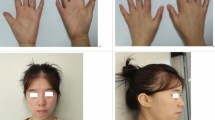Abstract
Duplications involving the X chromosome, in which the duplicated region is not subject to inactivation, are rare. We describe four distal Xq duplications, in three males and one female, in which the duplicated X chromosomal material is active in all cells. The infantile phenotype bears some resemblance to that of the Prader–Willi syndrome, presenting with initial feeding difficulties, hypotonia and, sometimes, with cryptorchidism. However, the severity of the phenotype is not simply related to the size of the duplication and so variations in gene expression, gene disruption or position effects from breakpoints should be considered as explanations. We have compared the clinical, cytogenetic and molecular findings of our patients with those previously reported. This has enabled us to question the suggestion that duplication of the gene SOX3 is the cause of hypopituitarism and that duplication of Filamin A is the cause of bilateral periventricular nodular heterotopia/mental retardation syndrome (BPNH/MR). We have also narrowed the putative critical interval for X-linked spina bifida.



Similar content being viewed by others
References
Akiyama M, Kawame H, Ohashi H, Tohma T, Ohta H, Shishikura A, Miyata I, Usui N, Et Y (2001) Functional disomy for Xq26.3-qter in a boy with and unbalanced t9X;21)(q26.3;p11.2) translocation. Am J Med Genet 99:111–114
Allen RC, Zoghbi HY, Moseley AB, Rosenblatt HM, Belmont JW (1992) Methylation of HpaII and HhaI sites near the polymorphic CAG repeat in the human androgen-receptor gene correlates with X chromosome inactivation. Am J Hum Genet 51:1229–1239
Bialer MG, Anguiano A, Taff I, Shanmughan A, LaGrave D, White BJ (2003) De novo trisomy Xq28-qter detected by subtelomeric FISH screening. Am J Hum Genet 73(Suppl 1):30
Carrel L, Cottle AA, Goglin KC, Willard HF (1999) A first-generation X-inactivation profile of the human X chromosome. Proc Natl Acad Sci USA 96:14440–14444
Dobyns WB, Guerrini R, Czapansky-Beilman DK, Piermont MEM, Breningstall G, Yock DH, Bonanni P, Truwit CL (1997) Bilateral periventricular nodular heterotopia with mental retardation and syndactyly in boys; a new X-linked mental retardation syndrome. Neurology 49:1042–1047
Fink JM, Dobyns WB, Guerrini R, Hirsch BA (1997) Identification of a duplication of Xq28 associated with bilateral periventricular nodular heterotopia. Am J Hum Genet 61:379–387
Fox JW, Lamperti ED, Eksioglu YZ, Hong SE, Feng Y, Graham D, Scheffer IE, Dobyns WB, Hirsch BA, Radtke RA, Berkovic SF, Huttenlocher PR, Walsh CA (1998) Mutations in filamin1 prevent migration of cerebral cortex neurons in human periventricular nodular heterotopia. Neuron 21:1315–1325
Fryns JP, Devriendt K, Moerman PH (1996) Lumbosacral spina bifida and myeloschizis in a female foetus with de novo X/autosomal translocation (t(X;22)(q27;q121). Genet Couns 7:159–160
Gecz J, Baker E, Donnelly A, Ming JE, McDonald-McGinn DM, Spinner NB, Zackai EH, Sutherland GR, Mulley JC (1999) Fibroblast growth factor homologous factor 2 (FHF2); gene structure, expression and mapping to the Borjeson-Forssman-Lehmann syndrome region in Xq26 delineated by a duplication breakpoint in a BFLS-like patient. Hum Genet 104:56–63
Goodman B, Shaffer LG, Rutberg J, Leppert M, Harum K, Gagos S, Ray JH, Bialer MG, Zhou X, Platcher BA, Shapira SC, Geraghty MT (1998) Inherited duplication Xq27-qter at Xp22.3 in severely affected males: molecular cytogenetic evaluation and clinical description in three unrelated families. Am J Med Genet 80:377–384
Hol F, Schepens MT, Beersum SEC van, Redolfi E, Affer M, Vezzoni P, Hamel BCJ, Karnes PS, Mariman ECM, Zucchi I (2000) Identification and characterisation of an Xq26-q27 duplication in a family with spina bifida and panhypopituitarism suggests the involvement of two distinct genes. Genomics 69:174–181
Knight SJ, Horsley SW, Regan R, Lawrie NM, Maher EJ, Cardy DL, Flint J, Kearney L (1997) Development and clinical application of an innovative fluorescence in situ hybridization technique which detects submicroscopic rearrangements involving telomeres. Eur J Hum Genet 5:1–8
Lagerstrom-Fermer M, Sundvall M, Johnsen E, Warne GL, Forrest SM, Zajac JD, Richards A, Ravine D, Landegren U, Pettersson U (1997) X-Linked recessive panhypopituitarism associated with a regional duplication in Xq25-q26. Am J Hum Genet 60:910–916
Lahn BT, Ma N, Breg WR, Stratton R, Surti U, Page DC (1994) Xq-Yq interchange resulting in supernormal X-linked gene expression in severely retarded males with 46,XYq- karyotype. Nat Genet 8:243–250
Lammer EJ, Punglia DR, Fuchs AE, Rowe AG, Cotter PD (2001) Inherited duplication of Xq27.2-qter: phenocopy of infantile Prader-Willi. Clin Dysmorphol 10:141–144
Laumonnier F, Ronce N, Hamel BCJ, Thomas P, Lespinasse J, Raynaud M, Paringaux C, Bokhoven H van, Kalscheuer V, Fryns J-P, Chelly J, Moraine C, Briault S (2002) Transcription factor SOX3 is involved in X-linked mental retardation with growth hormone deficiency. Am J Hum Genet 71:1450–1455
Miller SA, Dykes DD, Polesky HF (1988) A simple salting out procedure for extracting DNA from human nucleated cells. Nucleic Acids Res 16:1215
Mohandes T, Geller RL, Yen PH, Rosendorff J, Bernstein R, Yoshida A, Shapiro LJ (1987) Cytogenetic and molecular studies on a recombinant human X chromosome: implications for the spreading of X chromosome inactivation. Proc Natl Acad Sci USA 84:4954–4958
Nagaski K, Manabe T, Hanzawa H, Maass N, Tsukada T, Yamaguci K (1999) Identification of a new gene LDOC1, downregulated in cancer cell lines. Cancer Lett 140:227–234
National Institutes Of Health And Institute Of Molecular Medicine Collaboration (1996) A complete set of human telomeric probes and their clinical application. Nat Genet 14:86–89
Phelan PD, Connelly J, Martin FIR, Wettenhall HNB (1971) X-linked recessive hypopituitarism. Birth Defects 7:24–27
Pinkel D, Landegent J, Collins C, Fuscoe J, Segraves R, Lucas J, Gray J (1988) Florescence in situ hybridization with human chromosome-specific libraries: detection of trisomy 21 and translocations of chromosome 4. Proc Natl Acad Sci USA 85:9138–9142
Rizotti K, Brunelli S, Carmignac D, Thomas PQ, Robinson IC, Lovell-Badge R (2004) SOX3 is required during the formation of the hypothalamo-pituitary axis. Nat Genet 36:247–255
Roberts SE, Thomas NS (2003) A quantitative polymerase chain reaction method for determining copy number within the Prader-Willi/Angelman syndrome critical region. Clin Genet 64:76–78
Robertson SP, Twigg SRF, Sutherland-Smith AJ, Biacalana V, Gorlin RJ, Horn D, Kenwrick SJ, Kim CA, Morava E, Newbury-Ecob R, Orstavik KH, Quarell OWJ, Schwarz CE, Dhears DJ, Suri M, Kendrick–Jones J, The OPD-spectrum Disorders Clinical Collaboration Group, Wilkie AOM (2003) Localized mutations in the gene encoding the cytoskeletal protein filamin A cause diverse malformations in humans. Nat Genet 33:487–491
Sharp A, Robinson D, Jacobs P (2000) Age- and tissue-specific variation of X chromosome inactivation ratios in normal women. Hum Genet 107:343–349
Sheen VL, Dixon PH, Fox JW, Hong SE, Kinton L, Sisodiya S, Duncan JS, Dubeau F, Scheffer IE, Schachter SC, Wilner A, Henchy R, Crino P, Kamuro K, DiMario F, Berg M, Kuzniecky R, Cole AJ, Bromfield E, Biber M, Schomer D, Wheless J, Silver K, Mochida GH, Berkovic SF, Andermann F, Andermann E, Dobyns WB, Wood NW, Walsh CA (2001) Mutations in the X-linked filamin 1 gene cause periventricular nodular heterotopia in males as well as in females. Hum Mol Genet 10:1775–1783
Solomon NM, Nouri S, Warne G, Lagerstrom-Fermer M, Forrest SM, Thomas PQ (2002) Increased gene dosage at Xq26-q27 is associated with X-Linked hypopituitarism. Genomics 79:553–559
Vasquez AI, Rivera H, Bobadila L, Crolla JA (1995) A familial Xp + chromosome, dup(Xq26.3-qter). J Med Genet 32:891–893
Acknowledgements
We are very grateful to the families for participating in this research and also to Sam Baker, Chrisy Joyce and Nikki Savage for cytogenetic diagnosis, to Nicholas R Dennis for encouragement and for reading the manuscripts and the Wellcome Trust who supported the research.
Author information
Authors and Affiliations
Corresponding author
Rights and permissions
About this article
Cite this article
Lachlan, K.L., Collinson, M.N., Sandford, R.O.C. et al. Functional disomy resulting from duplications of distal Xq in four unrelated patients. Hum Genet 115, 399–408 (2004). https://doi.org/10.1007/s00439-004-1175-x
Received:
Accepted:
Published:
Issue Date:
DOI: https://doi.org/10.1007/s00439-004-1175-x




